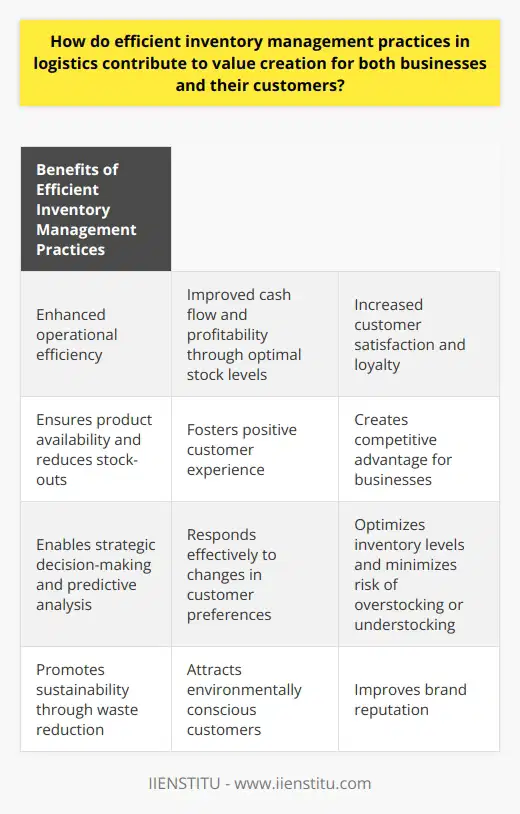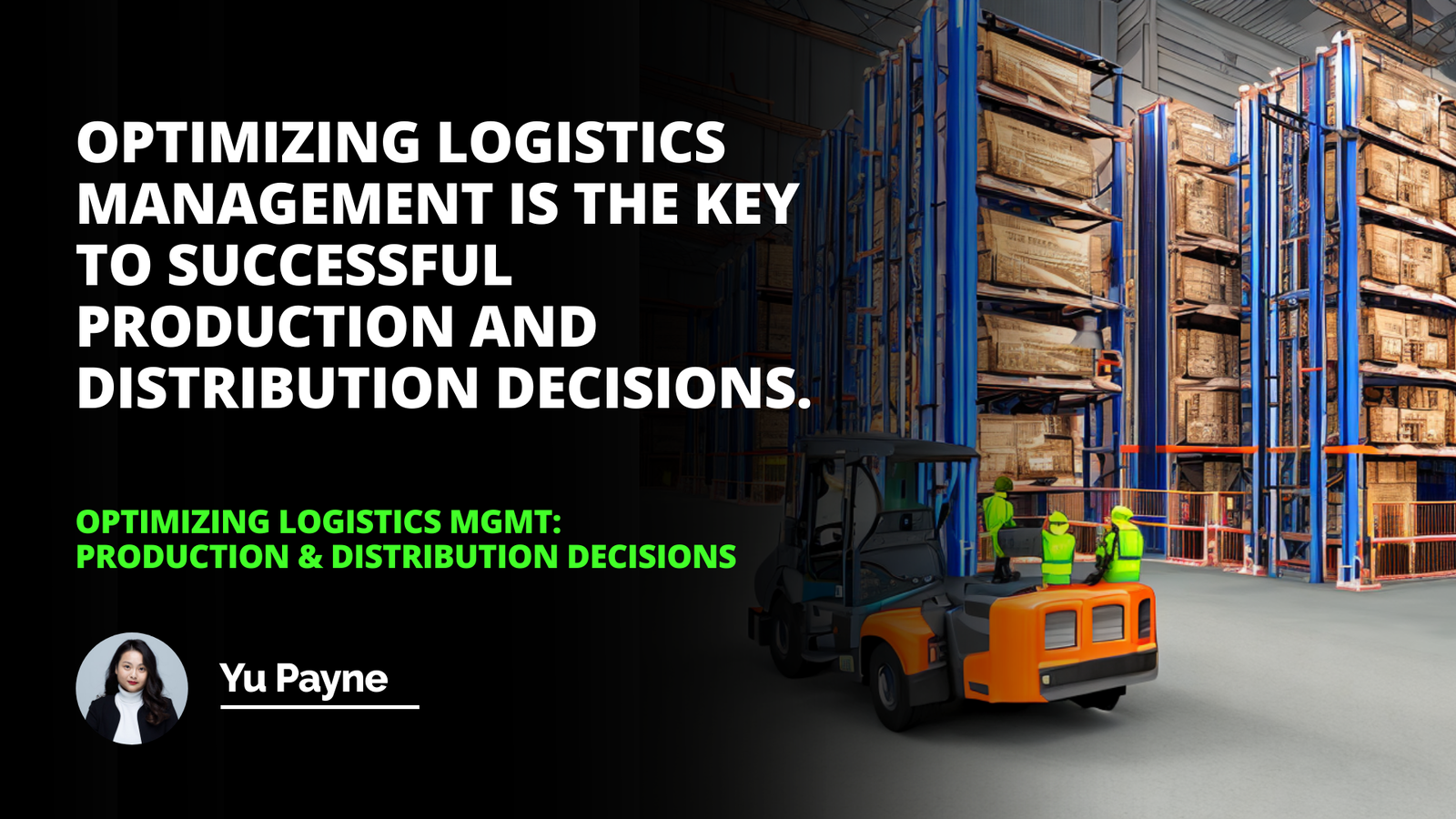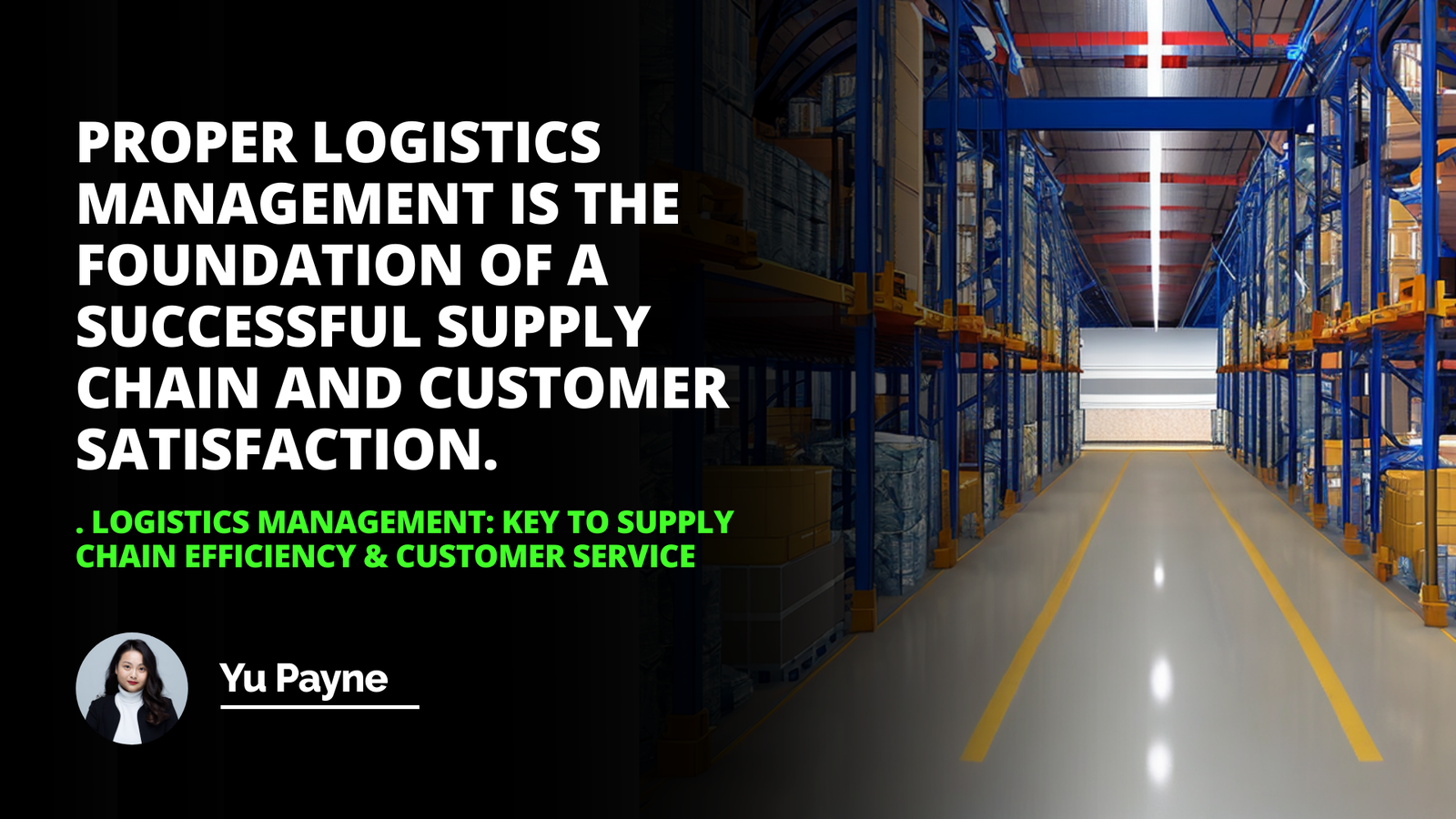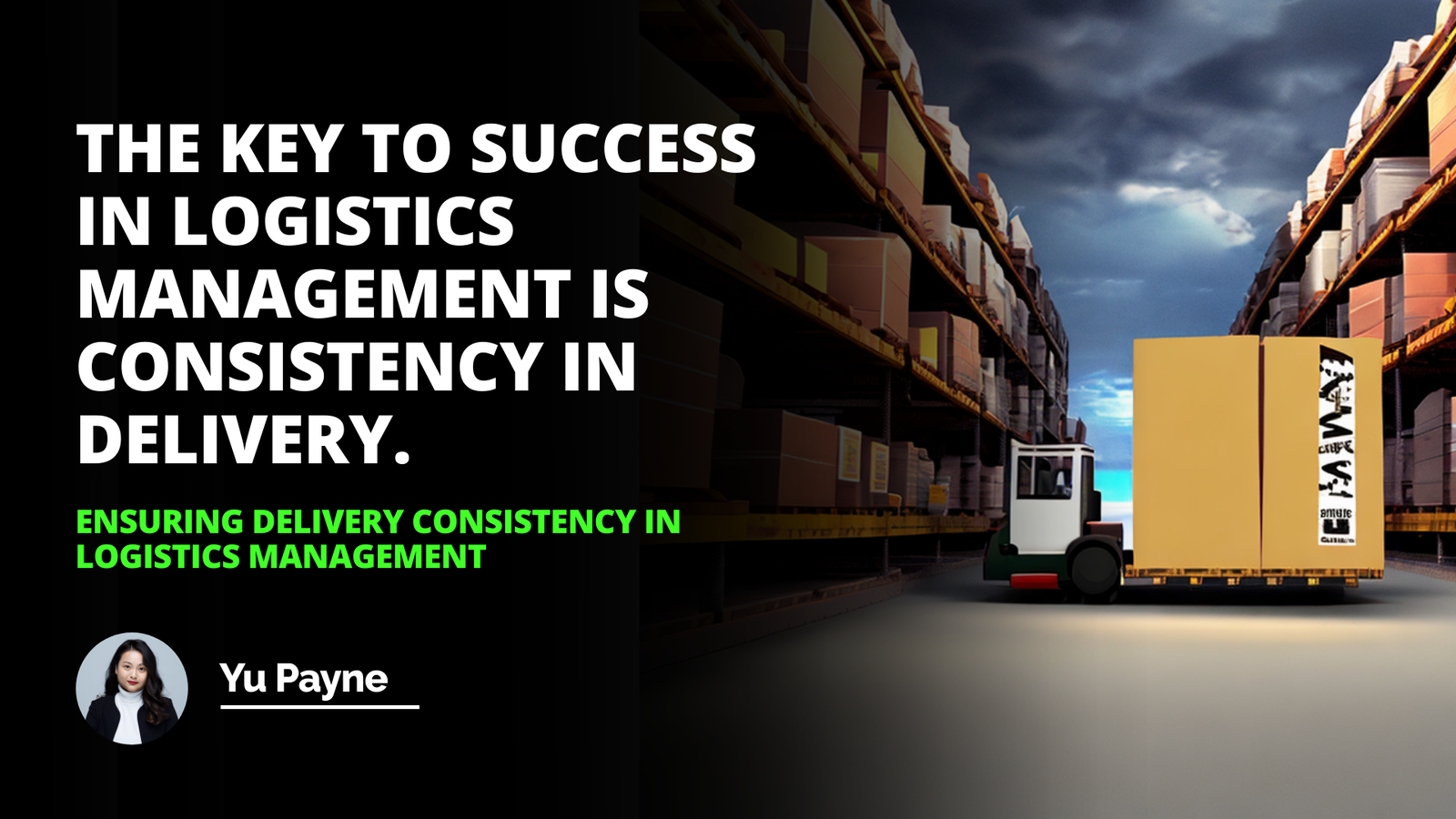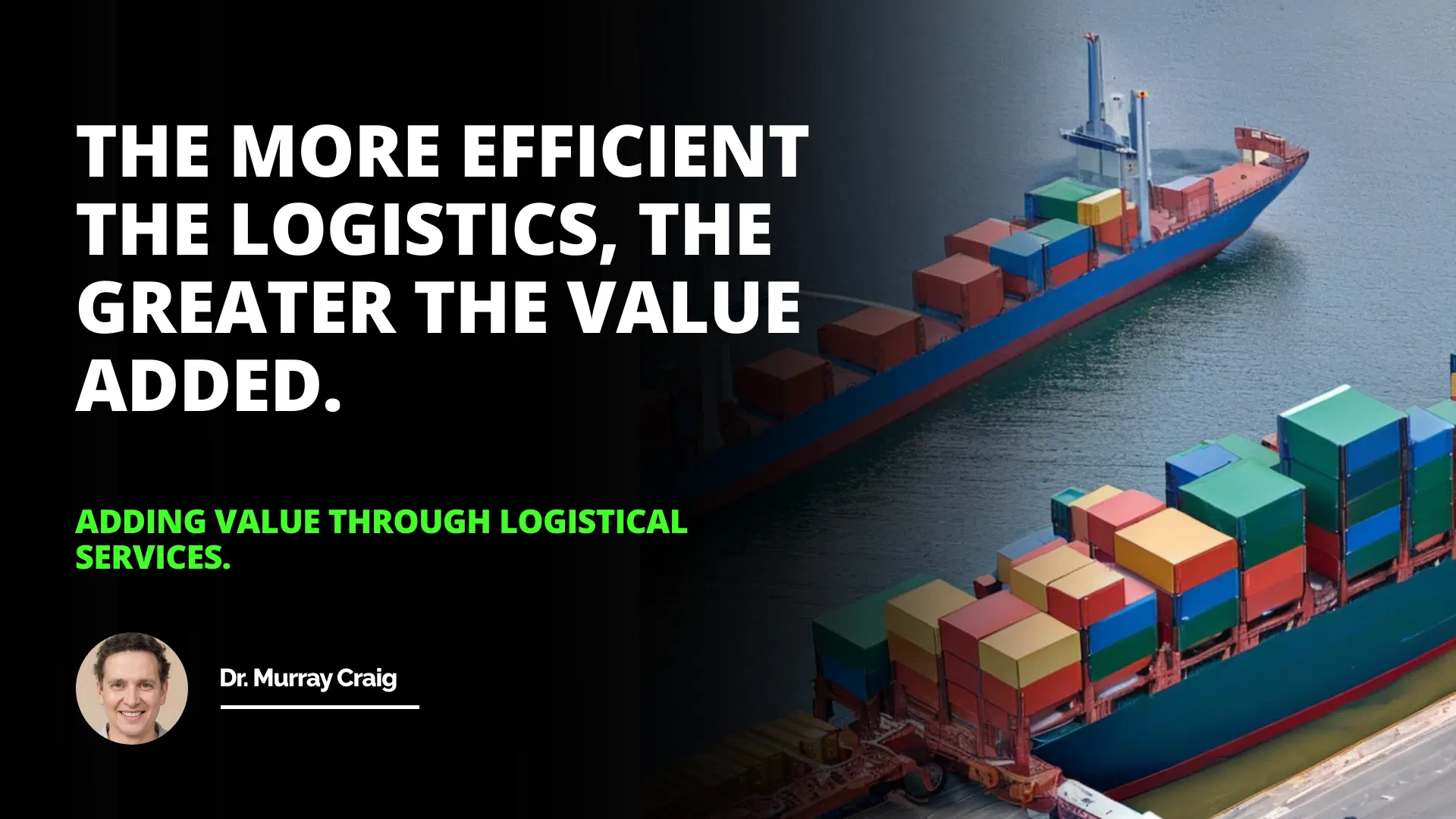
Unlocking the Power of Logistical Services: How Efficiency Drives Business Success
How Logistical Services Add Value
Benefits of Logistical Services
Challenges of Implementing Logistical Services
Growing up in a family-owned business, I vividly recall the afternoons spent in my father's small warehouse, watching him juggle orders, inventory, and shipments. He often joked that logistics was like the heartbeat of his company—unseen but vital. Little did I know then how profoundly logistical services would shape not just our family business but the entire landscape of modern commerce.
In today's fast-paced market, logistical services have evolved from mere behind-the-scenes operations to strategic drivers of value and growth. They are no longer just about moving products from point A to point B; they are about creating seamless, efficient processes that enhance customer satisfaction and boost profitability.
How Logistical Services Add Value
Logistical services add value by streamlining operations and enhancing the overall efficiency of a business. When my cousin, Sarah, decided to expand her online boutique, she faced challenges with order fulfillment and inventory management. By partnering with a third-party logistics provider, she was able to:
Advanced Planning And Scheduling İn Supply Chain Optimization Strategies
Optimizing Order Process Time İn Supply Chain Management Strategies
Optimize her supply chain, reducing delivery times.
Improve inventory accuracy, minimizing stockouts and overstock situations.
Enhance customer satisfaction through timely and accurate deliveries.
These improvements didn't just save her time; they boosted her bottom line. According to Logistics Management (Smith, 2018), companies that invest in advanced logistical solutions see an average of 15% increase in operational efficiency.
Carload Freight Supply Chain Management Benefits Challenges Strategies
Workforce Management Strategies To Boost Efficiency And Productivity İn Business
The Role of Technology
One of the key ways logistical services add value is through the integration of cutting-edge technology. For instance:
1- Transportation Management Systems (TMS): These platforms help businesses plan, execute, and optimize the physical movement of goods.
2- Warehouse Management Systems (WMS): They provide tools to control and manage daily warehouse operations.
3- Real-time Tracking: Offering visibility into the movement of goods, enhancing transparency.
By leveraging these technologies, companies can make data-driven decisions, reduce errors, and respond swiftly to market changes. As The Logistics Handbook (Johnson, 2020) states, "Incorporating technology is no longer optional; it's imperative for survival in a competitive market."
Benefits of Logistical Services
Embracing logistical services brings a multitude of benefits that can transform a business's operations.
Improved Efficiency
When I worked with a mid-sized manufacturing firm, one of our biggest hurdles was inefficient processes that led to delays and increased costs. Implementing logistical services helped us:
The more efficient the logistics, the greater the value added.
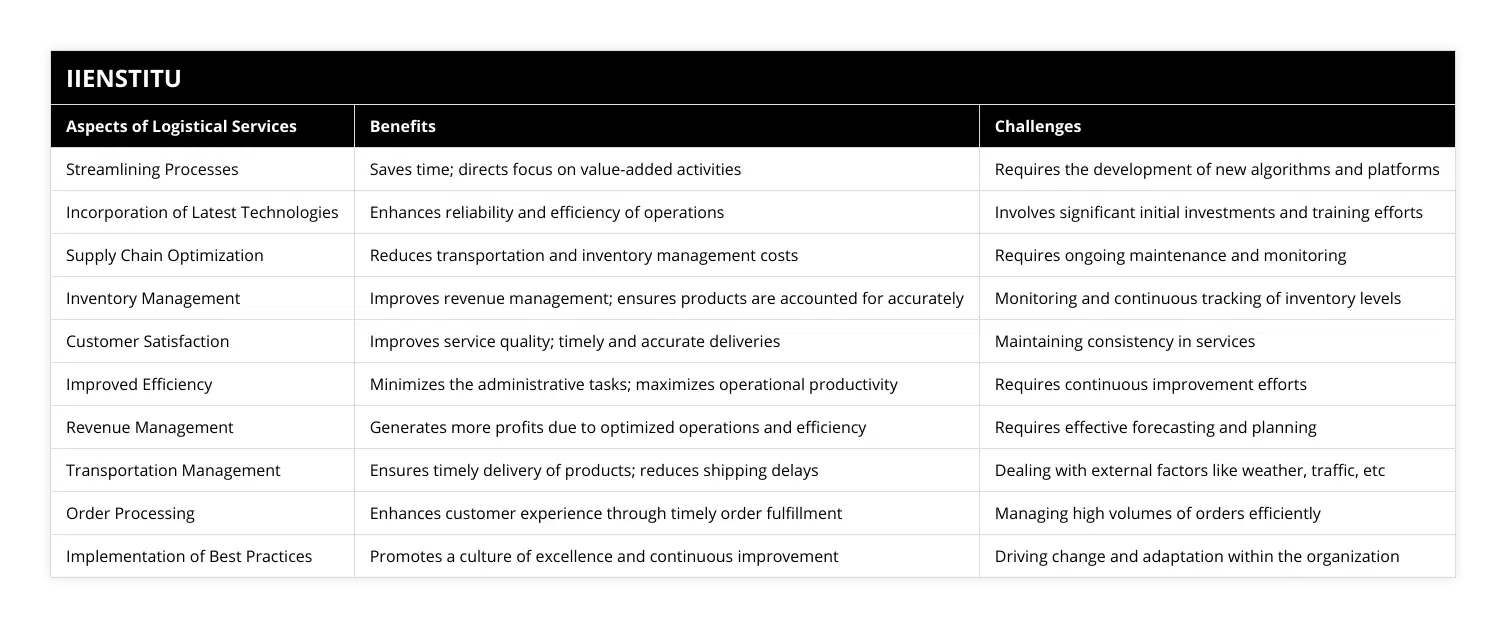
Automate routine tasks, freeing up staff to focus on strategic initiatives.
Standardize procedures, reducing variability and errors.
Enhance communication across departments, fostering collaboration.
These changes resulted in a 20% reduction in operational costs within a year.
Increased Customer Satisfaction
Customers today expect fast, reliable service. Logistical services enable businesses to meet these expectations by:
Ensuring timely deliveries.
Providing accurate order tracking.
Offering flexible delivery options.
A satisfied customer is more likely to become a repeat customer, contributing to long-term success. As Peter Drucker aptly said in Management Challenges for the 21st Century (Drucker, 1999), "The purpose of a business is to create and keep a customer."
Cost Reduction
Effective logistics can significantly reduce costs by:
1- Optimizing transportation routes, saving fuel and time.
2- Reducing inventory holding costs through better demand forecasting.
3- Minimizing returns and errors with accurate order fulfillment.
These savings can then be reinvested into the business for growth opportunities.
Challenges of Implementing Logistical Services
While the benefits are substantial, implementing logistical services isn't without its challenges.
Developing New Technologies
Investing in new technologies can be daunting. Businesses may face:
High initial costs for software and hardware.
Training requirements for staff to use new systems effectively.
Integration issues with existing processes.
However, these challenges can be mitigated by phased implementation and working with experienced providers.
Cost of Services
The financial investment required can be a significant hurdle, especially for small businesses. It's essential to:
Conduct a cost-benefit analysis to understand the potential ROI.
Explore scalable solutions that can grow with the business.
Seek expert advice to make informed decisions.
As highlighted in Supply Chain Logistics Management (Bowersox, 2013), "Strategic investment in logistics can lead to sustainable competitive advantage."
Change Management
Implementing new logistical services often requires a cultural shift within an organization. Employees may resist changes due to:
Fear of job displacement.
Uncertainty about new processes.
Lack of understanding of the benefits.
To overcome this, businesses should:
1- Communicate transparently about the changes and benefits.
2- Provide adequate training and support.
3- Involve employees in the implementation process.
Real-Life Example: From Chaos to Order
A friend of mine, Michael, managed a regional distribution company. He struggled with inefficient routing, leading to delayed deliveries and unhappy customers. After attending a seminar on logistical optimization, he decided to revamp his operations.
By implementing a Transportation Management System, he was able to:
Reduce fuel costs by 12%.
Improve on-time deliveries by 25%.
Increase customer satisfaction scores significantly.
Michael's story illustrates how investing in logistical services can transform a business. He often says, "The more efficient our logistics, the greater the value we add—not just to our customers but to our entire operation."
Tips for Successful Implementation
For businesses considering enhancing their logistical services, here are some practical tips:
1- Assess Your Current Operations: Understand where inefficiencies lie.
2- Set Clear Objectives: Define what you want to achieve—be it cost reduction, efficiency, or customer satisfaction.
3- Choose the Right Partners: Whether it's software providers or third-party logistics companies, make sure they align with your goals.
4- Invest in Training: Equip your team with the skills they need to succeed.
5- Monitor and Adjust: Continuously assess performance and be ready to make adjustments.
Incorporating Logistical Services in Reassignment Requests
Interestingly, the principles of logistics can also apply to internal organizational processes, such as handling reassignment request letters. Employees seeking new positions within a company can benefit from understanding logistical efficiency.
Reassignment Request Letter Tips and Information
When drafting a reassignment request letter, consider these logistical tips:
Be Clear and Concise: Just like efficient logistics, your letter should get to the point.
Highlight Relevant Skills: Align your abilities with the requirements of the new position.
Propose a Transition Plan: Show how you will ensure a smooth handover of your current responsibilities.
By applying logistical thinking, employees can streamline their request process, making it easier for management to approve and implement changes.
Conclusion
Logistical services are more than just an operational necessity; they are a strategic asset that can propel a business forward. From improving efficiency and reducing costs to enhancing customer satisfaction, the value added by efficient logistics is undeniable.
As I've seen through personal experiences and the successes of others, embracing logistical services can transform challenges into opportunities. Whether it's a family-owned business or a multinational corporation, the principles remain the same.
Investing time and resources into developing robust logistical processes is not without its hurdles, but the long-term benefits far outweigh the initial challenges. As the business landscape continues to evolve, those who prioritize logistics will not only survive but thrive.
References
Bowersox, D. J., et al. (2013). Supply Chain Logistics Management. McGraw-Hill.
Drucker, P. F. (1999). Management Challenges for the 21st Century. HarperBusiness.
Johnson, T. R. (2020). The Logistics Handbook. Routledge.
Smith, L. M. (2018). Logistics Management: Enhancing Efficiency and Effectiveness. Wiley.
Frequently Asked Questions
What key benefits does a third-party logistical service provider offer that can help to add value to a business?
Today’s business environment is increasingly competitive. To stay ahead of the curve, companies must be innovative and agile regarding their supply chain management. One way to strengthen supply chain operations and maintain competitiveness is by utilizing a third-party logistics service provider (3PL). 3PLs offer many key benefits that add value to the business, including access to technological advancements and cost savings.
Through their sophisticated technology platforms and a global network of carriers and warehouses, 3PLs enable companies to remain current with the latest trends and developments in logistics management. Providing access to more diverse service offerings and technological capabilities than most businesses can achieve on their own, outsourcing the tactical elements of logistics can help create a seamless supply chain that is both efficient and cost-effective.
Third-party providers offer a wide range of services spanning the entire logistics process, from supply chain planning and order fulfillment to returns management and reverse logistics. As a result, companies can minimize their logistics costs by centralizing the direction of their supply chain requirements and leveraging the provider’s existing resources. A 3PL partner can also provide in-depth analytics and insights into trends and changes in the marketplace, which can help improve operations and delivery.
Additionally, the hands-on support of a 3PL can help ensure companies adhere to customer service laws, government regulations, and industry compliance standards. Working with a 3PL partner helps avoid expensive errors, reduces operational risk, and ensures top customer service.
In conclusion, a 3PL provider can play an invaluable role in helping businesses navigate the ever-changing landscape of logistics management. Through access to advanced technology, cost savings, risk mitigation, and support in customer service standards, 3PLs can provide the critical value businesses need to remain competitive and successful.
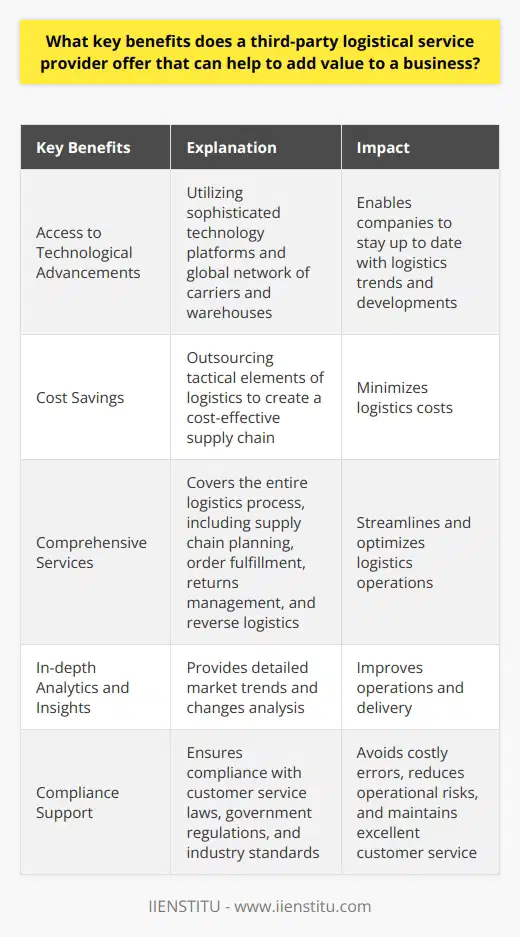
How can a business use its logistical resources to create a more efficient supply chain that adds value to customers?
Logistics plays a vital role in many businesses, especially those that deliver goods and services. Organizations can minimize costs with efficient supply chain management while maximizing customer value. Therefore, companies need to carefully consider the resources they have at their disposal to create a more efficient supply chain.
For starters, businesses should streamline the order management process and stakeholder communications. This can be done by leveraging available software, such as automated order processing systems, to reduce delays and errors and improve visibility within the supply chain. In addition, by using technology, organizations may minimize fulfillment times and improve customer communication.
Furthermore, businesses should consider investing in enterprise resource planning (ERP) software, which can automate many administrative tasks and provide insights into inventory management and product demand. With the help of this software, businesses can optimize the ordering process, track shipments and monitor delivery times -all of which could result in cost savings and increased customer satisfaction.
Additionally, businesses should work with their transportation partners to identify areas where they can improve the efficiency of their supply chain. For example, utilizing regional carriers and consolidating shipments can often significantly reduce transit time, transportation costs, and time spent handling goods. However, businesses must ensure that such solutions don’t hurt customer service or damaged goods during shipping.
Finally, organizations can leverage the available data to enhance the integration of their supply chain activities. By leveraging business intelligence platforms, businesses can gain greater insight into their data and use it to make informed decisions. This can help companies reduce waste and improve efficiency, resulting in cost savings, improved customer satisfaction, and increased profitability.
In summary, businesses can use their logistical resources to create a more efficient supply chain that adds value to customers. From streamlining processes to using technology to analyzing data, there are several strategies businesses can implement. By utilizing all available resources, companies can ensure that their supply chain remains efficient and cost-effective while delivering on customer expectations.
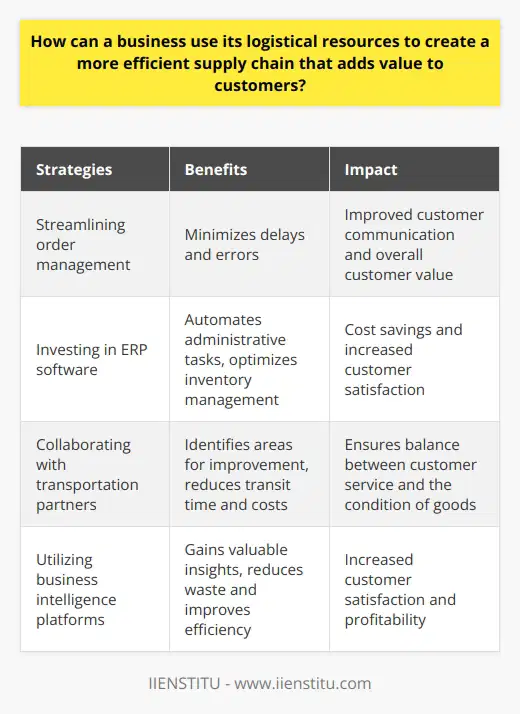
What measures should a business take to ensure that its logistical services remain cost-efficient and add value to its bottom line?
Logistics is an essential component of any business. Therefore, companies must develop effective strategies and systems to ensure efficient and cost-effective logistics services that add value to the bottom line. Here are some measures a business should take to provide the same:
Optimize Inventory Management: Effective inventory management helps businesses monitor and maintain sufficient stock levels so that customer orders can be fulfilled promptly and accurately. This leads to improved inventory visibility, reduced costs, and improved customer service.
Streamline Order-Picking Process: Businesses should optimize their order-picking process by deploying the latest technologies, such as voice picking, automated guided vehicles, and storage and retrieval systems. This will help reduce time, errors, and costs associated with manual order picking.
Outsource Logistical Services: Companies can outsource their logistical services to utilize specialized expertise and cost-effective labor. This also helps to focus on core business activities while leaving the fulfillment of logistics services to a third-party provider.
Automate Logistics Operations: Automation in logistics operations can help reduce the cost of storage and transportation, reduce the lead time and time-to-market, and ensure that customer orders are fulfilled accurately. Businesses should adopt robots, drones, and warehouse management systems for better automation.
Develop a Network of Transportation Partners: For an efficient supply chain, businesses should create a network of trusted transportation partners to provide reliable transportation services at competitive rates. This will help reduce delivery times and costs associated with transportation and lead to improved customer satisfaction.
By taking the abovementioned measures, businesses can ensure that their logistical services remain cost-efficient and add value to their bottom line. However, it is essential to note that the success of these measures depends mainly on the willingness of the companies to accept new technologies and outsource logistical services to third-party providers.
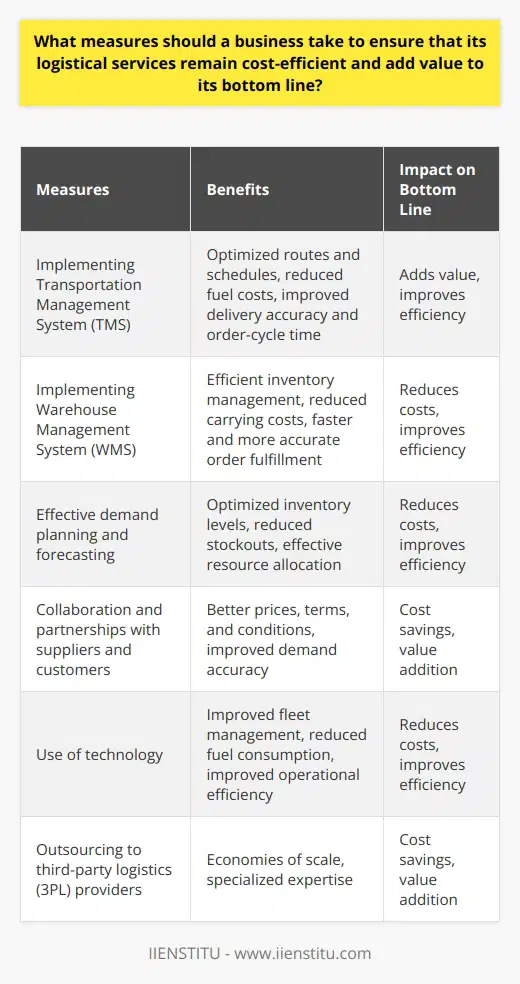
How does logistics add value to a company's overall performance?
Critical Role of Logistics in Company Performance
Efficient Logistics Management
Efficient logistics management is essential for any company seeking to improve its overall performance. It involves the detailed coordination of various processes, including procurement, transportation, warehousing, and distribution. By streamlining these processes, companies can optimize their supply chain, reduce costs, and enhance customer service.
Cost Reduction
One of the primary benefits of efficient logistics is cost reduction. By implementing faster and more reliable transportation methods, as well as optimizing warehouse operations, companies can reduce overall expenses. This, in turn, translates to higher profit margins and more competitive pricing, which can improve a company's position in the marketplace.
Improved Customer Service
Enhanced customer service is another critical value provided by effective logistics management. By ensuring that products are delivered on time and in excellent condition, companies can build trust with their customers and increase customer satisfaction. This not only leads to repeat business but also fosters positive word-of-mouth marketing, resulting in expanded market share.
Agility and Adaptability
A well-managed logistics system enables companies to be more agile and adaptable, allowing them to adjust to changing market demands or unforeseen situations. With a flexible supply chain, businesses can respond to fluctuations in customer needs, minimize the impact of supplier delays, and capitalize on emerging market trends, ultimately maintaining a competitive edge.
Inventory Management and Collaboration
Efficient logistics also enables better inventory management and collaboration among various stakeholders within the supply chain. By accurately tracking inventory levels and sharing information with suppliers, companies can avoid overstocking or stockouts, leading to reduced carrying costs and improved cash flow. Furthermore, collaboration fostered by effective logistics management can lead to innovations that benefit the entire supply chain network.
In conclusion, logistics plays a critical role in enhancing a company's overall performance. By enabling cost reduction, improved customer service, agility, adaptability, and effective inventory management, it adds significant value to an organization's operations. As companies continue to compete in an ever-evolving global market, effective logistics management remains crucial to maintaining a competitive advantage.

What are the key factors that contribute to the successful implementation of value-added logistics in an organization?
Assessing the Need and Scope
One of the critical factors that contribute to the successful implementation of value-added logistics (VAL) in an organization is determining the need and scope of these services. The organization must carefully assess its supply chain operations, identify areas where additional services can enhance the overall value proposition, and tailor solutions to fit the unique needs of its customers.
Understanding the Organization's Core Competencies
Another factor that plays a crucial role in implementing value-added logistics is understanding the organization's core competencies. This means focusing on specific areas in which a company excels, streamlining the organization's resources, and ensuring that the VAL offerings align with its expertise. A clear understanding of the organization's capabilities and limitations helps to manage customer expectations and deliver consistent quality.
Adopting Advanced Technologies
Next, organizations must adopt advanced technologies, such as automation, data analytics, and artificial intelligence, that enable them to execute value-added services effectively. These technologies help organizations streamline operations, proactively manage inventory, and optimize the utilization of resources, thereby reducing lead times and improving overall performance.
Collaborating with Supply Chain Partners
Additionally, close collaboration with supply chain partners, such as suppliers and third-party logistics providers (3PLs), can greatly contribute to the successful implementation of VAL. Establishing strong links with these partners fosters greater efficiency in the supply chain, facilitates information sharing, and ensures seamless integration of value-added logistics.
Developing a Flexible and Agile Organization
Moreover, creating a flexible and agile organization can significantly help in the success of value-added logistics. By fostering a culture of continuous improvement and adaptability, organizations can quickly respond to changes in customer demands, market conditions, and industry trends. This ability to adapt is essential in maintaining a competitive edge and delivering value-added services that enhance customer satisfaction.
Investing in Workforce Development
Lastly, organizations must invest in workforce development to ensure the effective implementation of VAL. This includes providing comprehensive training programs, promoting knowledge sharing, and creating an environment that encourages employee growth and development. A skilled and motivated workforce is essential for delivering high-quality value-added logistics services and maintaining a competitive advantage in the market.

In what ways can effective logistics management enhance customer satisfaction and drive business growth?
Logistics Management's Role in Customer Satisfaction
Effective logistics management can significantly enhance customer satisfaction by ensuring timely delivery of products, while maintaining product quality and availability. With e-commerce and global supply chains, customers increasingly expect shorter lead times and faster delivery of their orders. Therefore, businesses must optimize their logistics systems to meet these expectations and provide a seamless customer experience.
Inventory Management and Availability
One aspect of logistics management that directly impacts customer satisfaction is inventory management. By consistently monitoring and forecasting inventory levels, businesses can avoid stockouts and backorders, ensuring that customers receive their desired products on time. This creates a positive shopping experience, increasing the likelihood of repeat purchases and fostering long-term loyalty.
Efficiency and Cost-Effectiveness
Another benefit of effective logistics management is cost optimization. When logistics operations are efficient, companies can reduce transportation and warehousing costs, which can translate into lower prices for the consumer. Lower prices can further drive customer satisfaction and potentially attract new consumer segments, presenting opportunities for business growth.
Environmental and Social Sustainability
Many customers are increasingly concerned with the environmental and social impacts of their purchases, which brings the importance of implementing sustainable practices in logistics management. Green supply chain initiatives, such as adopting eco-friendly packaging or using renewable energy sources in warehouses, can enhance a company's reputation for sustainability and further boost customer satisfaction.
Real-Time Information and Transparency
Lastly, effective logistics management involves the use of technology to provide customers with real-time information, improving communication and transparency. For instance, customers can track their orders using tracking codes or receive notifications about shipment updates. This level of transparency allows customers to feel more involved in the process and instills trust in the company, elevating overall satisfaction.
Conclusion
In conclusion, effective logistics management plays a pivotal role in enhancing customer satisfaction and driving business growth. By ensuring product availability, maintaining efficient and cost-effective operations, incorporating sustainable practices, and improving communication and transparency, businesses can create a positive customer experience that fosters loyalty and attracts new consumer segments.

What are the essential components of a value-added logistics strategy?
Essential Components of Value-Added Logistics Strategy
Supply Chain Integration
A value-added logistics strategy needs seamless integration throughout the supply chain, which entails connecting the necessary activities and stakeholders, such as suppliers, manufacturers, and distributors. This integration helps optimize cost efficiency, improve time management, and enhance customer satisfaction.
Inventory Management
Efficient inventory management is crucial to ensure that products are available when required, avoid stockouts or excess stock, and reduce warehousing costs. The adoption of advanced inventory management techniques, such as just-in-time and demand forecasting, can be beneficial for the value-added logistics strategy.
Information Management
Effective information management is necessary to collect, process, and transmit data throughout the supply chain efficiently. This includes the use of information technology systems and tools, such as enterprise resource planning (ERP) and electronic data interchange (EDI), to improve visibility, allow real-time tracking, and facilitate decision-making.
Customization and Personalization
To create value for customers, a value-added logistics strategy should offer customization and personalization options. This may entail adding specific features, packaging, or services tailored to customers' needs, preferences, and expectations, which can boost overall satisfaction and loyalty.
Sustainable Practices
A value-added logistics strategy should incorporate sustainable practices to reduce environmental impact, improve waste management, and demonstrate corporate social responsibility. This includes implementing green supply chain management initiatives, such as reducing energy consumption, encouraging suppliers to adopt eco-friendly practices, and using recyclable materials in packaging and logistics processes.
Quality Control
Ensuring product quality is another essential component of a value-added logistics strategy. This incorporates stringent quality control processes and procedures, ranging from raw material selection to final product testing before delivery to customers, to guarantee products meet or exceed expectations.
Agile and Responsive Supply Chain
Lastly, an agile and responsive supply chain is crucial for success in today's dynamic and competitive market. A value-added logistics strategy should be flexible enough to accommodate fluctuations in demand, supply disruptions, and changing customer preferences. This involves fostering a collaborative culture, implementing advanced planning and forecasting techniques, and continuously refining logistics processes to enhance adaptability and responsiveness.
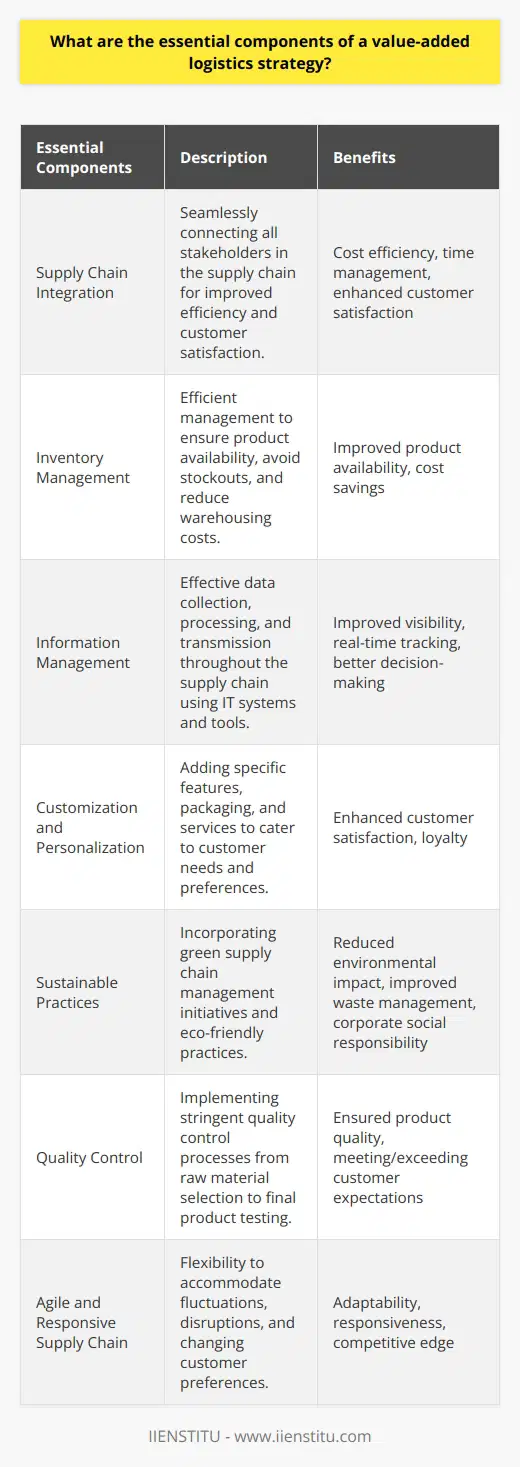
How can organizations leverage technology in logistics to create value for their customers and improve efficiency?
Leveraging Technology in Logistics
Organizations can create value for customers and improve efficiency by leveraging technology in their logistics operations. These technologies enable companies to streamline the supply chain, enhance communication, and reduce costs. There are various ways to do so:
Data-driven Decision-making
Logistics companies can rely on big data and analytics to make informed decisions. This approach optimizes the allocation of resources, allowing firms to better serve their clients. By identifying patterns and trends, companies can anticipate customer needs and enhance the overall efficiency of their operations.
IoT and Real-time Tracking
The Internet of Things (IoT) allows for real-time monitoring of shipments throughout the supply chain. Sensors and tracking devices can send updates directly to clients, thereby improving transparency and enhancing customer satisfaction. Real-time tracking also helps businesses in swiftly adjusting their operations, ensuring the timely delivery of goods.
Machine Learning and Automation
Integrating machine learning and automation can save time and reduce error in logistics processes. This technology enables warehouses to automate inventory management, picking, and packing. Furthermore, it allows companies to forecast demand, ensuring they can timely fulfill customers' requests, avoiding stockouts or surpluses.
Blockchain for Secure Transactions
The blockchain technology can improve security and transparency in the supply chain. It creates an immutable record of transactions, ensuring accurate tracking and reducing the risk of fraud. This level of security is attractive to customers and can lead to increased trust in an organization.
Smart Contracts
These digital contracts can be automatically executed upon the fulfillment of specific conditions. Smart contracts improve the efficiency of supply chain transactions by accelerating agreement negotiations and ensuring reliable execution. As a result, they reduce delays and minimize the possibility of disputes.
In conclusion, technology, when effectively applied in logistics operations, brings considerable benefits to organizations and their clients. By leveraging advanced technologies, companies can streamline their processes, increase transparency, and tailor their services to customer needs. This approach can lead to improved efficiency, client satisfaction, and overall business growth.
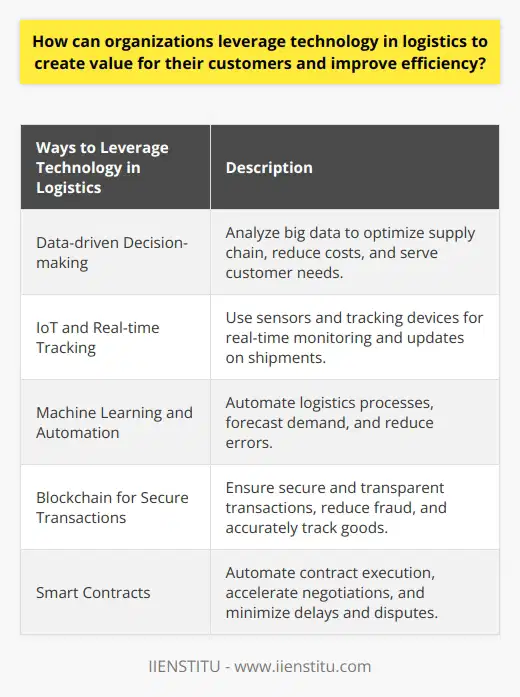
Which performance metrics are most relevant for assessing the success of a value-added logistics approach?
Relevant Metrics for Value-Added Logistics Measurement
Operational Efficiency Indicators
One must look at operational efficiency indicators such as order accuracy, order cycle time, and delivery time to ascertain the effectiveness of a value-added logistics approach. These indicators reveal how well the adopted strategy streamlines logistic processes and fulfills customer expectations.
Inventory Management Metrics
Efficient inventory management is crucial in a value-added logistics approach. Metrics such as inventory turnover, stock accuracy, and carrying costs shed light on areas to optimize inventory management and maintain a lean operation, thus driving competitive advantage.
Customer Satisfaction Parameters
Monitoring customer satisfaction parameters is essential for fine-tuning a value-added logistics approach. Metrics like on-time delivery, order fulfillment rate, and customer service response time help gauge the effectiveness of the strategy in meeting customer expectations and building long-term relationships.
Cost-related Metrics
A successful value-added logistics approach should result in cost savings. Analyzing cost-related metrics, such as transportation costs, warehousing costs, and logistics management expenses, will provide insight into the financial benefits generated by the strategy and guide decision-making for continuous improvement.
Benchmarking and Comparison
In addition to the above metrics, comparing performance against industry standards and competitors allows companies to identify gaps and areas of improvement. Assessing attributes like market share, customer retention rate, and growth rates can help businesses evaluate the success of their value-added logistics approach and make necessary adjustments.
In conclusion, identifying relevant performance metrics is essential for evaluating the success of a value-added logistics approach. Factors such as operational efficiency, inventory management, customer satisfaction, cost management, and benchmarking must be considered to ensure a comprehensive understanding and informed decision-making.

How does logistics add value to the decision-making process in an organization?
Impact on Decision-Making Process
Logistics plays a crucial role in the decision-making process of an organization by contributing to operational efficiency, cost-effectiveness, and customer satisfaction. By streamlining and optimizing the movement and storage of goods throughout the supply chain, logistics ensures a smooth flow of processes, enabling businesses to make well-informed decisions based on accurate and timely information.
Operational Efficiency
A well-organized logistics system contributes to operational efficiency by minimizing bottlenecks, reducing lead times, and enhancing the overall productivity of the organization. This allows stakeholders to have a clear understanding of the current state of operations, enabling them to make data-driven decisions that align with the company's objectives and goals.
Cost-Effectiveness
Logistics helps organizations identify areas for cost reduction by analyzing transportation, warehousing, and inventory management costs. In turn, this enables decision-makers to allocate resources strategically, ultimately improving the overall profitability of the business. Furthermore, cost-effective logistics operations contribute to the competitiveness of the organization in the market, allowing for better decision-making in terms of market positioning and pricing strategies.
Customer Satisfaction
By ensuring the timely delivery of products and services, logistics plays a vital role in maintaining customer satisfaction. This directly impacts the decision-making process, as organizations prioritize the allocation of resources towards improving customer experience and addressing potential issues in the supply chain. In addition, satisfied customers are more likely to provide valuable feedback, which can inform the company's strategic decisions related to product development, marketing, and expansion.
Risk Management
Logistics is also instrumental in identifying potential risks within the supply chain, such as delays, disruptions, and supplier issues. This information allows decision-makers to proactively manage risks and mitigate their impact on the organization. By analyzing and addressing uncertainties in the supply chain, logistics aids in establishing a more resilient organization that can effectively adapt to change.
In conclusion, logistics adds significant value to the decision-making process in an organization by fostering operational efficiency, boosting cost-effectiveness, enhancing customer satisfaction, and facilitating effective risk management. By optimizing and streamlining processes within the supply chain, logistics provides the necessary insights for organizations to make informed decisions that ultimately contribute to their success in a competitive marketplace.
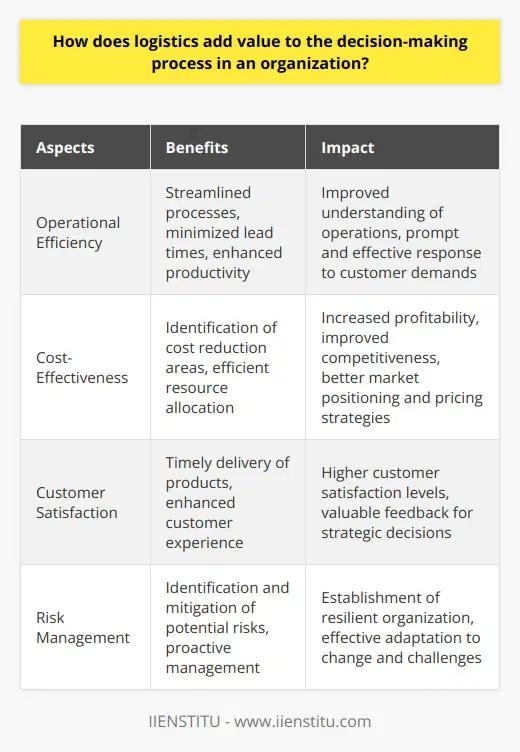
What role does effective communication play in ensuring that logistics adds value to customer experience?
Role of Effective Communication
Effective communication is paramount in ensuring that logistics adds value to the customer experience. It facilitates the efficient transfer of information among all stakeholders in the supply chain, promoting seamless coordination of processes.
Information Exchange and Collaboration
Effective communication ensures that all parties involved in logistics, including suppliers, transporters, distributors, and retailers, have access to relevant information. Improved information sharing enables timely decision-making and optimal resource allocation. This, in turn, helps to minimize delays in the supply chain and improve service delivery.
Fostering Customer Relationships
A clear and open communication channel between a company and its customers is vital in building trust and long-term relationships. Information on product availability, delivery status, and any unforeseen challenges can be promptly shared, allowing customers to have a sense of control and predictability in their purchasing experience.
Predicting and Addressing Customer Needs
By actively engaging in conversations with customers, businesses can understand their needs and expectations better. This understanding enables companies to align their logistics strategies with customers' preferences, thus delivering tailored experiences that enhance satisfaction.
Dynamic Response to Market Changes
Effective communication in logistics helps companies stay attuned to market trends and adapt swiftly to changing customer demands. This agility allows businesses to maintain a competitive edge and drive customer experience improvements that enhance brand loyalty.
Problem Resolution and Feedback
Effective communication expedites problem-solving within the logistics sector. Rapid identification and resolution of issues contribute to reduced downtime in the supply chain, minimizing the adverse impact on customer experience. Furthermore, feedback loops encourage continuous improvement by providing insights into the areas that require adjustments.
In summary, effective communication is the linchpin of successful logistics management. It fosters collaboration, enhances customer relationships, facilitates tailored experiences, and drives responsiveness and continuous improvement in the supply chain. Therefore, businesses must prioritize the development and implementation of efficient communication strategies to ensure a seamless and value-adding customer experience.
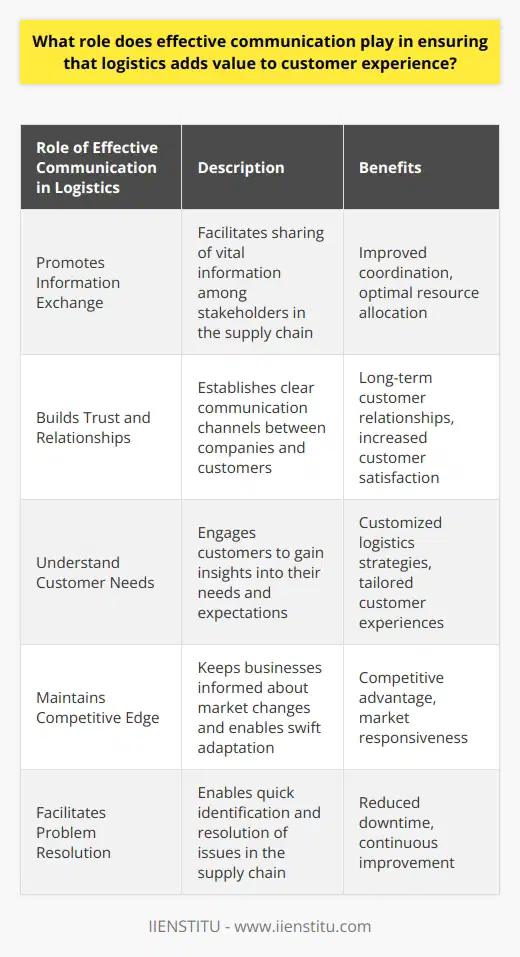
How can sustainable and environmentally-friendly practices in logistics contribute to creating value for both the organization and its customers?
**Value Creation through Green Logistics**
Sustainable and environmentally-friendly practices in logistics can create substantial value for organizations and their customers. By adopting green logistics, organizations demonstrate their commitment to environmental protection, leading to improved brand reputation and customer loyalty.
**Reduced Environmental Impact**
One of the measures to create sustainable logistics is reducing the environmental impact of transportation. By optimizing transportation routes and using fuel-efficient vehicles, organizations can cut down on greenhouse gas emissions. Additionally, reverse logistics can ensure proper disposal or recycling of products, minimizing waste generation.
**Operational Efficiency**
Green logistics also contribute to increased operational efficiency. Efficient packaging practices can reduce material usage and transportation costs due to decreased weight and volume. Furthermore, real-time tracking, enabled by advanced technologies, allows organizations to monitor shipments, streamline processes, and eliminate bottlenecks, resulting in cost savings.
**Customer Satisfaction**
Environmentally conscious customers are increasingly choosing companies that prioritize sustainability. By adopting green logistics practices, organizations can cater to the demands of environmentally aware customers, meeting their expectations while promoting positive environmental values. This satisfaction can translate into long-term loyalty and repeat business over time.
**Regulatory Compliance**
Green logistics practices contribute to organizations' compliance with environmental regulations and standards. Proper waste management and reduction of emissions mitigate legal risks and potential fines. Compliance with regulations also improves organizations' standings with investors and stakeholders, opening opportunities for funding and strategic partnerships.
**Innovation and Market Differentiation**
Implementing sustainable logistics can foster innovation within the organization. By focusing on sustainability, businesses will need to develop new products, processes, and services to stay competitive in the market. This continuous improvement culture can lead to a stronger market position, higher customer retention, and increased profitability.
In conclusion, adopting sustainable and environmentally-friendly practices in logistics is a win-win strategy for both organizations and their customers. Organizations can significantly reduce their environmental impact, increase operational efficiency, enhance customer satisfaction, maintain regulatory compliance, and foster innovation. This value creation through green logistics strengthens companies' competitive advantage while aiding in global efforts to protect our environment.

How does logistics add value by enhancing the overall customer experience?
Enhancing Customer Experience through Logistics
Effective Inventory Management
Logistics plays a crucial role in enhancing overall customer experience by ensuring efficient and effective inventory management. Streamlined flow of products from suppliers to warehouses and retail outlets minimize stockouts and ensure that customers always find what they need when they need it. The availability of required items is directly proportional to customer satisfaction.
Efficient Order Processing
Efficient order processing is another aspect where logistics adds value to customer experience. Prompt and accurate order processing reduces the waiting time, enabling customers to receive their products quickly. Timely delivery increases customer satisfaction, resulting in positive reviews, repeat purchases, and brand loyalty.
Cost Reduction Benefits
Logistics can contribute to cost reduction through optimized transportation, storage, and distribution channels. Reduced operational costs allow businesses to offer competitive pricing and pass on the savings to customers. Lower prices without compromising quality or delivery time can greatly enhance customer satisfaction and overall experience.
Customized Delivery Options
Logistics provides customers with a range of delivery options to suit their preferences and schedules. By offering flexible delivery solutions such as next-day delivery, same-day delivery, or desired-time delivery, logistics providers cater to diverse customer needs. Tailoring the delivery experience to each customer segment enhances their overall experience and fosters customer loyalty.
Visibility and Communication
Logistics adds value to the customer experience by providing end-to-end visibility and communication throughout the supply chain. Real-time tracking of shipments coupled with proactive communication of potential delays or issues enables customers to plan accordingly and reduces the scope for dissatisfaction. Transparency and proactive communication go a long way in ensuring a positive customer experience.
Return and Exchange Management
A streamlined return and exchange process is essential for maintaining customer satisfaction. By simplifying these processes through efficient logistics, businesses can enhance their customers' overall experience, building trust and a positive brand image. Satisfied customers are more likely to become loyal, returning customers, further adding to the bottom line.
To conclude, logistics significantly contributes to enhancing the overall customer experience by ensuring effective inventory management, efficient order processing, cost reduction benefits, customized delivery options, visibility and communication, and streamlined return and exchange management. As businesses increasingly recognize the importance of customer experience in their long-term success, effective logistics management becomes a vital component of their strategy.
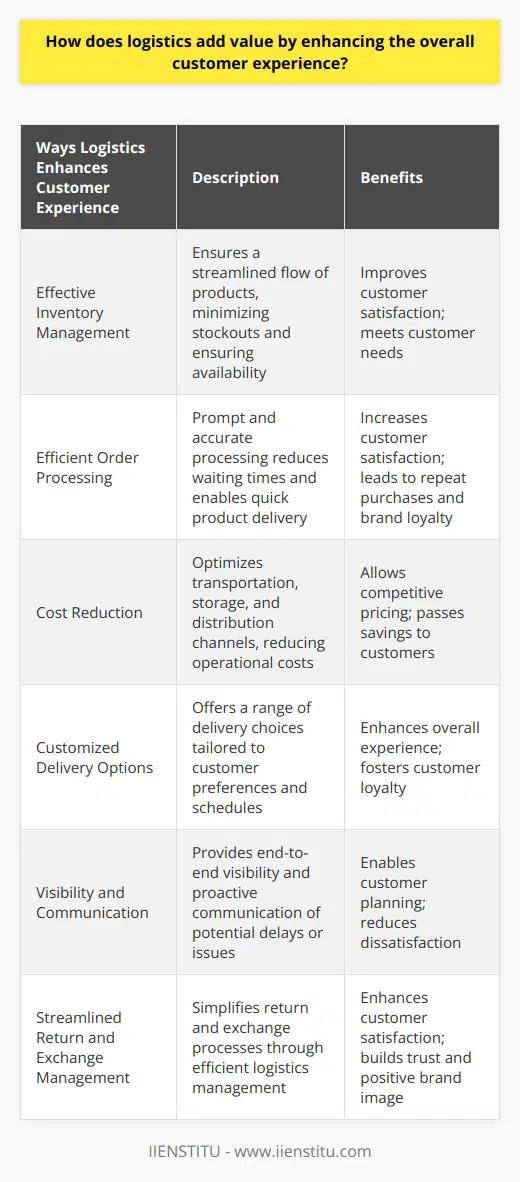
What factors determine the effectiveness of value-added logistics in meeting evolving customer demands?
Factors Influencing Value-Added Logistics Effectiveness
Understanding Customer Needs
A key factor determining the effectiveness of value-added logistics in meeting evolving customer demands is a company's ability to understand and anticipate customer needs. This entails monitoring customer preferences and purchasing patterns, as well as collecting feedback to adjust and improve services.
Integration of Technology
The incorporation of advanced technology plays a vital role in enhancing logistical processes. Technologies such as warehouse management systems, data analytics, and automation can significantly improve efficiency and reduce errors, allowing businesses to better respond to changing customer demands.
Supply Chain Collaboration
Effective collaboration among various supply chain partners is essential in ensuring the timely and accurate delivery of value-added logistic services. Close communication, information sharing, and joint planning efforts among suppliers, manufacturers, and transportation providers can lead to improved coordination and streamlined operations.
Flexibility and Adaptability
In a constantly changing business environment, the ability to quickly adapt and modify value-added logistic services is crucial. Companies must be flexible and able to respond to sudden market shifts, innovative technologies, and new regulations to maintain their competitive edge and meet customer demands.
Tailored Solutions
Providing customized logistic solutions to clients is another essential factor in meeting evolving customer demands. Personalized services, ranging from specific packaging requirements to customized delivery schedules, can result in increased customer satisfaction and brand loyalty.
Continuous Improvement
A culture embracing continuous improvement is vital to the effectiveness of value-added logistics. Regularly evaluating and refining processes, training staff, and adopting best practices can highlight areas of improvement to optimize operations and better serve customers.
In conclusion, the effectiveness of value-added logistics in meeting customer demands largely depends on understanding customer needs, integrating technology, fostering supply chain collaboration, remaining flexible and adaptable, providing tailored solutions, and committing to continuous improvement. By addressing these crucial factors, businesses can enhance their value-added logistic services and better meet the ever-changing needs of their customers.
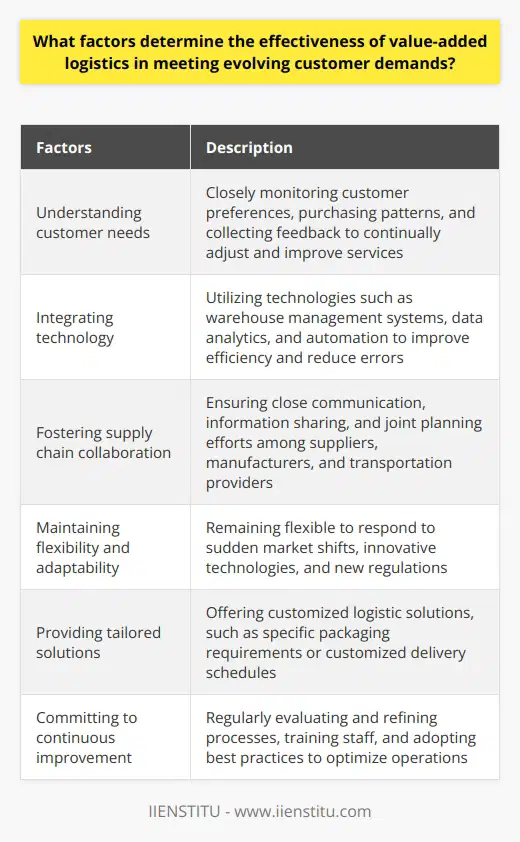
What role does collaboration and partnerships within the supply chain play in achieving value-added logistics goals?
Role of Collaboration and Partnerships in Value-Added Logistics Goals
Enhancing Efficiency
Collaboration and partnerships within the supply chain play a crucial role in achieving value-added logistics goals by enhancing efficiency in multiple areas. Implementing coordinated approaches between different actors, such as suppliers, manufacturers, transportation providers, and distributors, facilitates the seamless flow of products and information, reducing lead times and waste.
Leveraging Synergies
In addition, strategic alliances enable various supply chain partners to leverage each other's strengths, resources, and expertise, fostering innovation and the development of end-to-end solutions. This results in better optimization of resources, cost reductions, and overall performance improvements, contributing to the achievement of value-added logistics goals.
Improving Visibility
Moreover, strong partnerships within the supply chain aid in improving visibility and transparency of operations, allowing for better demand forecasting and inventory management. The use of information-sharing platforms and tools, such as blockchain technology and artificial intelligence, promotes data-driven decision-making processes, enhancing the ability to respond to market fluctuations and customer demands promptly.
Risk Mitigation
Furthermore, collaboration and partnerships contribute to risk mitigation, ensuring the resiliency of the supply chain. By working together, companies can collectively address potential issues, implement contingency plans, and minimize the impact of disruptions such as natural disasters, geopolitical tensions, and economic uncertainties. This leads to a more reliable and robust supply chain, ultimately supporting value-added logistics goals.
Customer-Centric Approach
Lastly, collaboration enables a customer-centric approach in the supply chain, where all members align with the customers' preferences and expectations. Ensuring customer satisfaction is vital in achieving a competitive edge and value-added logistics goals, as it leads to increased brand loyalty, higher sales and customer retention rates.
In conclusion, collaboration and partnerships within the supply chain play an essential role in achieving value-added logistics goals by enhancing efficiency, leveraging synergies, improving visibility, mitigating risks, and enabling customer-centric approaches. By fostering strong, strategic alliances, supply chain actors can optimize their operations, streamline processes, and ultimately contribute to the delivery of value-added services that meet or exceed customer expectations.
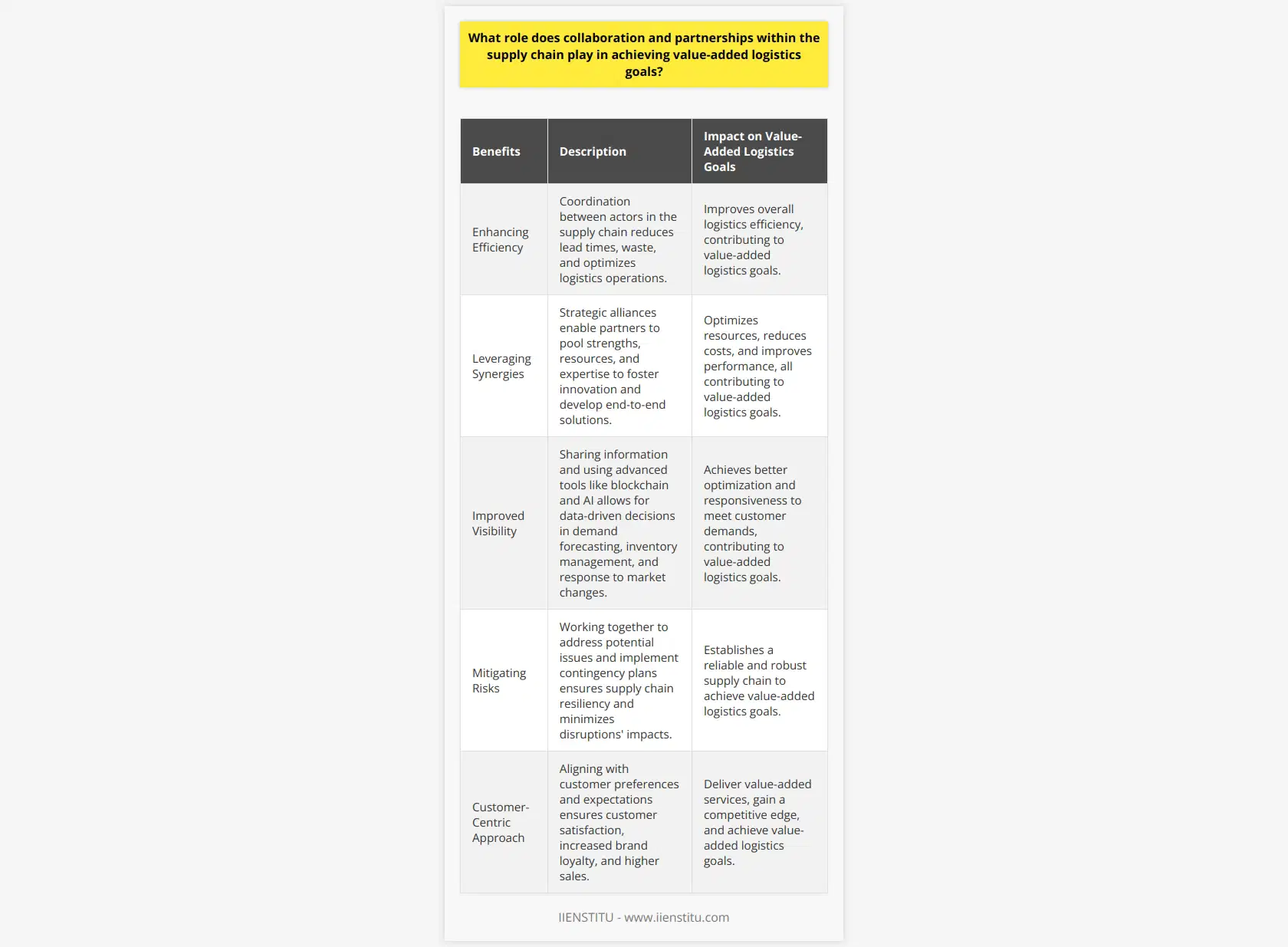
How does logistics add value by streamlining and optimizing supply chain processes?
Logistics Efficiency in Supply Chains
Logistics adds value through enhancing the efficacy of supply chain processes. It ensures that the flow of goods is smooth from the point of origin to the consumer, minimizing delays and errors.
Supply Chain Optimization
The first step to streamlining supply chain processes is by optimizing supply chain operations. With meticulous planning and the use of technology, logistics improves efficiency. Advanced systems and software aid in inventory management. Logistics also enhances customer service by ensuring on-time delivery and product availability.
Reduced Costs and Increased Profitability
Moreover, logistics plays a crucial role in cost reduction. It identifies and eliminates non-value-adding activities, leading to better profit margins. By creating efficient routes and schedules, it minimizes fuel costs and increases the speed of delivery.
Logistics Integration
Integration is another essential aspect where logistics adds value. It integrates different processes and functions within the supply chain, enabling seamless collaboration. This eliminates bottlenecks and speeds up operations from procurement to delivery.
Risk Management
Logistics also aids in risk management within the supply chain. It identifies potential hazards and develops strategies to mitigate those risks. Good logistics planning includes contingency plans in case of disruptions, ensuring the stability of the supply chain.
In conclusion, logistics adds significant value by streamlining and optimizing supply chain processes. By enhancing efficiency, reducing costs, integrating processes, and managing risks, logistics improves the overall performance of the supply chain. This ultimately results in customer satisfaction and improved profitability.
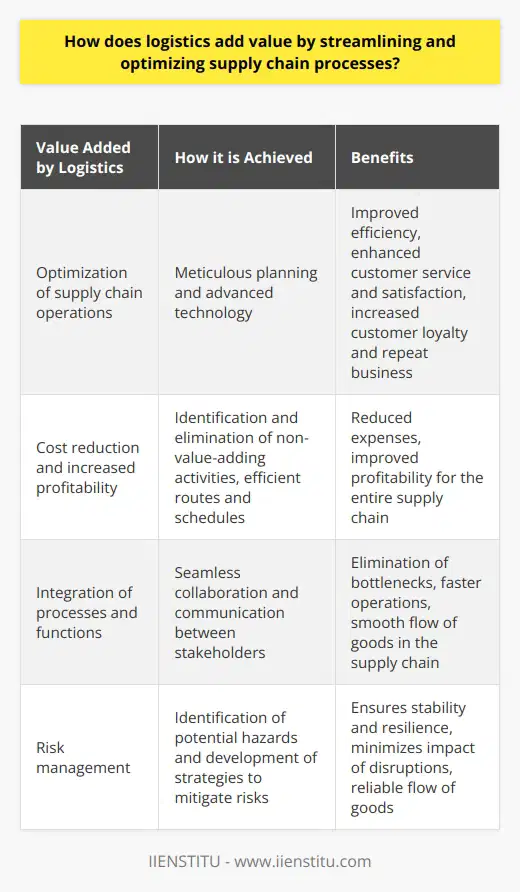
What are some ways in which integrating innovative technologies into logistics operations can result in value-added services?
Enhanced Tracking and Visibility
Firstly, innovative technologies boost tracking and visibility in logistics. Radio Frequency Identification (RFID) and Global Positioning System (GPS) technologies promote real-time tracking. This shift away from manual tracking saves valuable time. Real-time updates allow more informed decision making.
Improved Efficiency and Reduced Errors
Next, technologies like Robotic Process Automation (RPA) and Artificial Intelligence (AI) enhance efficiency. They reduce the probability of errors in logistical operations. This improvement in accuracy is vital in order fulfillment, inventory management, and shipping processes.
Predictive Analytics for Improved Forecasting
Also, the incorporation of predictive analytics into logistics improves forecasting. Machine learning algorithms can predict demand patterns and supply chain disruptions. This foreknowledge enables proactive measures, ensuring a smoother, more reliable logistical operation.
Sustainability and Waste Reduction
Moreover, technology promotes sustainable logistics practices. Software solutions can optimize routes, reducing fuel consumption and carbon emissions. Additionally, IoT-enabled devices can monitor energy usage, supporting waste reduction efforts.
Improved Customer Service
Lastly, innovative technologies can improve customer service. Automated customer service bots provide swift responses to queries. Moreover, advanced analytics can personalize customer experiences. This impacts client retention positively and enhances brand loyalty.
In conclusion, integrating innovative technologies into logistics operations can result in value-added services. These include improved visibility, efficiency, forecasting, sustainability, and customer service. Therefore, the ongoing digital transformation of the logistics sector promises significant benefits.
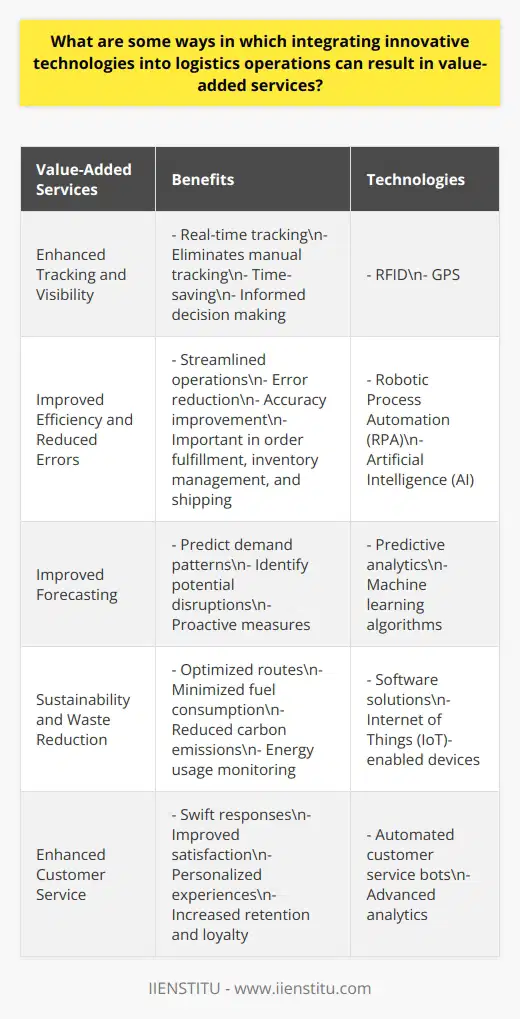
How do efficient inventory management practices in logistics contribute to value creation for both businesses and their customers?
Enhancing Operational Efficiency
Effective inventory management practices drastically improve operational efficiency for businesses. The capacity to monitor and regulate stock levels reduces excess inventory and storage costs. It allows firms to achieve optimal stock levels, reducing tied-up capital and aiding cash flow.
Boosting Customer Satisfaction
From a customer's perspective, efficient inventory management ensures product availability. This increases customer satisfaction as it prevents stock-outs and backs up timely delivery. When businesses routinely meet customer expectations for product availability and speed, it fosters customer loyalty.
Facilitating Value Addition
Inventory management plays an instrumental role in value creation. By fostering efficiency and customer satisfaction, it indirectly enhances a company's perceived value. Businesses become more attractive to consumers, nurturing a competitive advantage that translates into increased profitability.
Catalyzing Strategic Business Decisions
Additionally, it supports the making of informed strategic decisions. Accurate inventory data allows for predictive analysis, facilitating proactivity in demand and supply management. This ability to anticipate demand and supply changes helps businesses stay ahead of market trends.
Promoting Sustainability
Additionally, efficient inventory management promotes sustainability. Reducing overstock excludes unnecessary waste, aiding environmental sustainability. This aspect of value creation is crucial nowadays, as consumers are more prone to support businesses that demonstrate ecological responsibility.
In sum, efficient inventory management in logistics significantly contributes to value creation for both businesses and their customers. By increasing operational efficiency, boosting customer satisfaction, catalyzing strategic business decisions, and promoting sustainability, it enriches the value added to all stakeholders. This highlights the need for businesses to prioritize and continually improve their inventory management practices.
